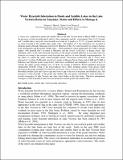| dc.contributor.author | Ndunguru, J | |
| dc.contributor.author | Mjema, P | |
| dc.contributor.author | Rajabu, CA | |
| dc.contributor.author | Katagira, F | |
| dc.date.accessioned | 2015-11-12T06:24:56Z | |
| dc.date.available | 2015-11-12T06:24:56Z | |
| dc.date.issued | 2001 | |
| dc.identifier.citation | Water Hyacinth Infestation in Ponds and Satellite Lakes in the Lake Victoria Basin on Tanzania: Status and Efforts to Manage it. 1Ndunguru J.,1Mjema P., 1Rajabu C.A and 2Katagira F. 1Plant Protection Division, Box 1484, Mwanza, Tanzania, Tel: 255-28-2500458 2Plant Protection Division, Box 9071, Dar es Salaam | en_US |
| dc.identifier.uri | http://hdl.handle.net/11671/825 | |
| dc.description.abstract | A survey was conducted in ponds and satellite lakes in the lake Victoria basin in March 2000 to ascertain
the presence of water hyacinth and its effect to the communities and the environment. Out of 14 (12 ponds
and 2 satellite lakes) surveyed, water hyacinth was found in 11 ponds (i.e. 91.7% of ponds) and there was
no water hyacinth in the satellite lakes under study. The highest (31.5 ha) infestation was recorded at
Ngulyati pond in Bariadi, Shinyanga followed by Bukabwa (8 ha). No water hyacinth was found at Sarawe
pond, Itabagumba and Buswahili satellite lakes. Plant population varied significantly (P< 0.001) with the
highest (196 plants/0.25m2) recorded at Bukabwa and the lowest (21/0.25m2) at Bunda ponds. The
immediate effect of the water hyacinth infestation in the ponds included difficulty in accessing water for
domestic use owing to the extensive water hyacinth mats and loss of water through evapotranspiration. In
the efforts to control the weed, water hyacinth weevils’ Neochetina eichhorniae and N. bruchi were
released in 7 of them (9,600 adult weevils in 5 ponds at Mwanza Prison Center and 44,000 and 52,600 at
Bukabwa and Ngulyati ponds respectively) which have established and multiplied to a level of up to 8
weevils per plant causing feeding scars of 38.65 on average at Ngulyati. Weed population decreased
significantly (P<0.05) owing to the insect-induced stress. Other dominant aquatic weed species found
growing in the ponds included Ceratophylum dermesum, Pistia stateotes, Rapa natas and Brasenia SP at
Buswahili Satellite Lake and Cyperus spp and Justicia spp in the rest of the ponds and Satellite Lake. The
presence of water hyacinth in the ponds and satellite lakes has partly contributed to water hyacinth regrowth
(resurgence) in lake Victoria and other water bodies in the lake basin. Therefore management
strategies of water hyacinth in Lake Victoria should also include ponds and satellite lakes. | en_US |
| dc.language.iso | en | en_US |
| dc.publisher | Lake Victoria Environmental Management Project (LVEMP) | en_US |
| dc.subject | Ponds | en_US |
| dc.subject | Satellite lake | en_US |
| dc.subject | Water hyacinth | en_US |
| dc.subject | Infestation | en_US |
| dc.title | Water Hyacinth Infestation in Ponds and Satellite Lakes in the Lake Victoria Basin on Tanzania: Status and Efforts to Manage it. | en_US |
| dc.type | Article | en_US |

